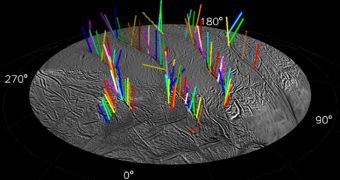Just yesterday, researchers with NASA announced the discovery of as many as 101 active geysers on the surface of Enceladus, Saturn's sixth largest moon. The find is detailed in two articles available in the Astronomical Journal.
In a press release, NASA explains that the 101 geysers were discovered with the help of Cassini, a robotic spacecraft that has been studying Saturn and its many satellites since 2004, when it reached this part of the solar system.
As detailed by the astronomers behind this research project, the Cassini spacecraft spent a total of 7 years closely monitoring geological activity in the icy moon's south polar region, an area displaying fractures similar to tiger stripes.
By the looks of it, it is from these tiger stripe-like geological formations that the 101 geysers erupt on a regular basis. The location of the geysers coincides with small hot spots, NASA researchers detail in the Astronomical Journal.
Having identified these geysers in the south polar region of Saturn's sixth largest moon, scientists explain that their presence on Enceladus indicates that, as icy as this world might be, it also accommodates for liquid water.
Astronomers say that Enceladus houses a sea just beneath its ice shell, and that the 101 geysers owe their existence to this body of water. Specifically, the geysers are believed to have been birthed and to be fueled by condensation of vapor on the fractures' near-surface walls.
“Individual geysers were found to coincide with small-scale hot spots, only a few dozen feet (or tens of meters) across, which were too small to be produced by frictional heating, but the right size to be the result of condensation of vapor on the near-surface walls of the fractures,” NASA says.
This contradicts previous claims that geysers on this icy moon are the result of heat-generating frictional processes resulting in the formation of vapor and liquid, scientists with NASA comment in the press release documenting this find.
“Once we had these results in hand, we knew right away heat was not causing the geysers, but vice versa. It also told us the geysers are not a near-surface phenomenon, but have much deeper roots,” says Carolyn Porco with the Space Science Institute in Boulder, Colorado.
Data obtained with the help of the Cassini spacecraft indicates that the plume originating from these geysers changes in brightness depending on where Enceladus is located in relation to Saturn. By the looks of it, tidal activity has a say in the matter. Still, specialists suspect other environmental factors are also at play.

 14 DAY TRIAL //
14 DAY TRIAL //